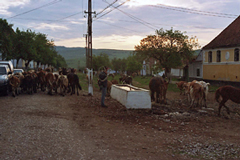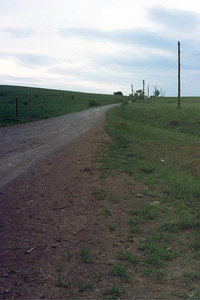
 Above: The herdsmen collects the Above: The herdsmen collects the
animals and takes them out to pasture each morning.
Top: Sheep at a sheep fold in the hills surrounding Viscri. |

One of the most important decisions the residents of Viscri will make is whether to pave the road that leads to their village.
Village Life Today
Viscri sits at the crossroads of tradition and modernity. The village is small, with a population of roughly 400, about 30 of which are Saxon, most identify themselves as Romanian, and a few identify themselves as Roma or gypsies. The majority of villagers would be described as poor or disadvantaged and village economy is based on subsistence farming, barter and tourism. Many of the families own at least a few animals and have a small yard where they grow crops for food. Animal products such as milk, meat, and eggs are often sold, but new regulations that come with Romania's induction into the European Union in January of 2007 will change that. For instance, EU requires cows to be milked by machine and that milk be pasteurized, however few families will be able to afford the expensive milking machines.
Despite the hardships, some families are taking advantage of new opportunities in the village, such as running guest houses and preparing meals for the tourists who visit the fortified church. Non-governmental organizations (NGOs) are active in the area. Projects include restoring the facades of the old Saxon houses and other buildings, teaching the villagers how to set up small production kitchens to prepare homemade products, such as jams and jellies, as specialty products for sale throughout the EU, and running a cooperative for women, who knit socks and other goods for sale in the village and throughout Europe. All of these projects employ people from the village to provide them usually with what amounts to a small supplemental income.
What makes Viscri attractive to visitors is the romantic ideal it represents, the idea of a simpler life in a simpler time. To some extent, this is true: mornings begin at daybreak to the sounds of the wild cuckoos and the crack of the herdsman's whip as he gatheres the village animals to take them out to pasture. The day is spent tending fields and other animals, to end at sundown, as the animals are brought back home, and cows are milked one last time before settling into bed for a good night's sleep in the quiet village. However, village life is not an easy life. Day-to-day existence requires heavy labor just to make ends meet, and many villagers work far too much, especially as they get older, often jeopardizing their health, because they cannot afford to lose a day's work, for it means not being able to provide basic necessities.
Challenges
Infrastructure
Education
Information
Technology
Infrastructure
Basic infrastructure is lacking in Viscri. While electricity arrived in the village in the early 1960's, only a handful of the houses have indoor plumbing - and most of those are guesthouses that have been recently restored or renovated to serve the tourists who visit the village. Since the mid-1990's, two phone lines have provided phone service to the village, and those are located in the post office. Trash collection has become more important with the introduction of plastics (mainly bottles) into the village in the recent past (before this, there was very little trash produced). Similarly, basic services such as medical care are limited, with a nurse visiting the village twice a week and the nearest hospital a good 45 minutes away. Public transportation is nonexistent, and villagers rely on horse and cart or bartering with neighbors who have cars for rides to travel to nearby villages or to haul things home.
Education
Elementary education is provided through fourth grade at the school in Viscri. Most children in the village attend school until fourth grade, and the majority continue classes through eighth grade, which are offered at the neighboring village of Bunesti, about 7km away. Local NGOs and non-profits have raised enough funds to provide transportation to Bunesti, but the unpaved road often makes travel difficult, especially in winter months. Few students from Viscri and neighboring villages attend high school because they often must stay home and work on the family farm or tending the animals to help support their families. Attending the high school or college is cost-prohibitive for most, since students would have to live away from home in a larger town to attend secondary school.
When village educators were asked what they would like their students to have to give them a better education, they identified computers, materials for craft projects (like construction paper, crayons, paint), sports equipment (like a soccer ball), and also running water, so the children could practice better hygeine by being able to wash their hands while at school.

The library at Viscri's elementary school. (Photo by Amelia Bowen)
Information
The villagers we spoke to reported relying on television or newspapers for news about current events. Many of the homes have satellite dishes, although we were told that service was provided by the satellite company for free for the first three months, after which time residents could not afford the monthly fee, so service would be discontinued. Anecdotal reports of a high rate of illiteracy or low reading ability were also indicated. Keeping with the charm of the village, there is also still a town crier who rides through the village to make important announcements, and we were told that sometimes jobs available in the village through the NGOs were posted on flyers throughout the community.
There is no library or community center in Viscri. What was referred to as the library in the elementary school (see photo above), consisted of books mostly from the 1960's and 1970's, in no particular order, still containing the Communist stamp. These books were on shelves in a room that was off-limits to students. There were a dozen new books in German and one in English. These books were used one of the residents who had recently relocated to Viscri, who volunteered her time to provide foreign language instruction in German, which is not part of the regular curriculum. We were told that the school in Bunesti has a bigger library with one computer, but most of the children in Viscri are not able to take advantage of the resources in Bunesti.
Technology
What exists in Viscri is not so much a digital divide as a digital chasm. A handful of residents could afford cell phones, and only three families were identified as owning computers. While most residents had heard of computers or about the Internet, few had actually seen a computer, let alone had used one. One woman indicated that she did not really know what the Internet was, but if it could help them sell more knitted goods, then she thought it was a good thing and that the village needed more access to the Internet. Residents who used the Internet connected via a dial-up connection using a cell phone as modem.
One of the residents who wanted a computer was working to afford one: she had calculated that she had to purchase and raise 23 lambs for six months, after which point she could sell them for enough cash to purchase a new desktop computer (the cost of which would be roughly equivalent to US$1000).
Why paving the road is such a hard decision
Paving the road to Viscri would improve access to the "outside world" for villagers. A paved road would allow better transportation, and possibly even public transportation, to nearby towns and villages, where there are often better job opportunities. It would make Viscri feel less cut off and be more a part of the more modern cities that are nearby. Herein lies the problem. Better access for villagers out of the village also means better access for outsiders into the village. Certainly, the one main street of Viscri lined with tour buses (many of which will not make the trip into Viscri for insurance reasons) would change the charming, "lost-in-time" quailty of the village for visitors and residents alike. Similarly, who is the village for? Is it being turned into a museum, stopped in time, to enchant tourists? Or is it a small but viable community who needs some assistance making the transition from subsistence economy to one that is more integrated into the modern world?

The unpaved road that leads to Viscri. |


